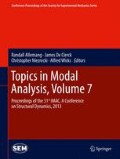Abstract
Robust damage detection algorithms are the first requirement for development of practical structural health monitoring systems. Typically, a damage decision is made based on time series measurements of structural responses. Data analysis involves a two-stage process, namely feature extraction and classification. While classification methods are well understood, no general framework exists for extracting optimal, or even good, features from time series measurements. Currently, successful feature design requires application experts and domain-specific knowledge. Genetic programming, a method of evolutionary computing closely related to genetic algorithms, has previously shown promise as an automatic feature selector in speech recognition and image analysis applications. Genetic programming evolves a population of candidate solutions represented as computer programs to perform a well-defined task such as classification of time series measurements. Importantly, genetic programming conducts an efficient search without specification of the size of the desired solution. This preliminary study explores the use of genetic programming as an automated feature extractor for two-class supervised learning problems related to structural health monitoring applications.
Access this chapter
Tax calculation will be finalised at checkout
Purchases are for personal use only
References
Koza JR (1992) Genetic programming: on the programming of computers by means of natural selection. MIT, Cambridge
Poli R, Langdon WB, McPhee NF (2008) A field guide to genetic programming. Published via http://lulu.com and freely available at http://www.gp-field-guide.org.uk (with contributions by Koza JR)
Conrads M, Nordin P, Banzhaf W (1998) Speech sound discrimination with genetic programming. In: Proceedings of the first European workshop on genetic programming, Paris, pp 113–129. April 1998
Acknowledgements
This work was supported by the Department of Defense (DoD) through the National Defense Science and Engineering Graduate Fellowship (NDSEG) Program.
Author information
Authors and Affiliations
Corresponding author
Editor information
Editors and Affiliations
Rights and permissions
Copyright information
© 2014 The Society for Experimental Mechanics
About this paper
Cite this paper
Harvey, D., Todd, M. (2014). Automated Selection of Damage Detection Features by Genetic Programming. In: Allemang, R., De Clerck, J., Niezrecki, C., Wicks, A. (eds) Topics in Modal Analysis, Volume 7. Conference Proceedings of the Society for Experimental Mechanics Series. Springer, New York, NY. https://doi.org/10.1007/978-1-4614-6585-0_2
Download citation
DOI: https://doi.org/10.1007/978-1-4614-6585-0_2
Published:
Publisher Name: Springer, New York, NY
Print ISBN: 978-1-4614-6584-3
Online ISBN: 978-1-4614-6585-0
eBook Packages: EngineeringEngineering (R0)

